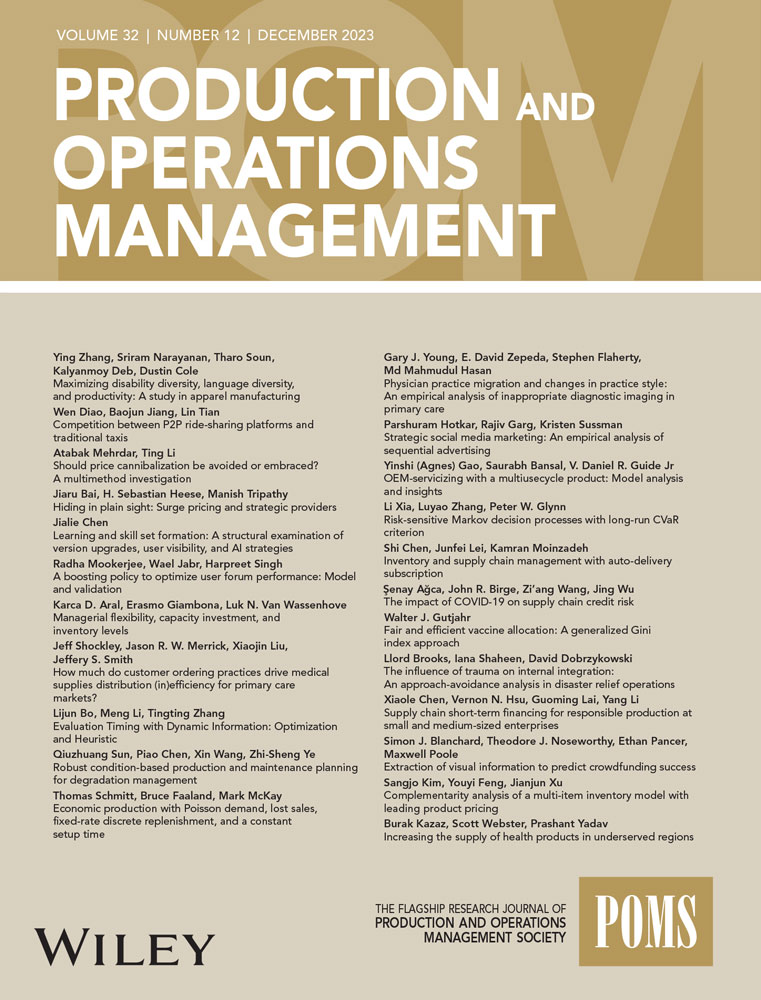It's not simply luck: the impact of network strategy, schedule padding, and operational improvements on domestic on‐time performance in the US airline industry
IF 5.1
3区 管理学
Q1 ENGINEERING, MANUFACTURING
引用次数: 0
Abstract
Airlines showcase their on‐time performance (OTP), a globally accepted operational performance metric, to demonstrate punctuality, service reliability, and attract air travelers. Airlines can adopt passive strategies, such as “schedule padding”, and active strategies, such as making “operational changes/improvements”, to improve their OTP. While there is a high degree of variation in airlines' OTP from year to year, it is unclear if and the extent to which airlines' active or passive actions impact their OTP because of factors, like weather, outside an airline's control. We develop a framework in this paper to study the impact of these active and passive actions on the OTP of airlines. Additionally, we study the effect of these strategies on OTP rankings, routinely used to compare airlines. Our methodology builds on the structural estimation model developed in prior literature and replicates the typical schedule planning process observed in the airline industry. We use an eleven‐year panel data of flights operated by US domestic carriers from 2005 to 2015 to measure OTP changes, schedule padding, and operational changes. Broadly, active actions include (i) changes to the airline's network structure (for example, flight routes and schedules), and (ii) other operational changes to improve flight performance (operational improvement). We demonstrate through our analysis that operational improvements have the highest association with both the change in OTP and OTP rankings of airlines, followed by schedule padding; the impact of network changes on OTP and OTP rankings is the lowest. Our framework also accounts for the impact of competition on an airline's OTP ranking. We show that while an airline's own actions can improve its OTP ranking, a competitor's action may negatively affect the ranking. In fact, a competitor's passive strategy of schedule padding may have a higher impact than an airline's own active strategy of changes in network structure. Our results also indicate that the potential impact of operations improvements is the highest for full‐service airlines and the lowest for leisure airlines. Furthermore, we show that the impact of operational improvements and buffer adjustments decreases with an increase in the variability of the travel time of a route.This article is protected by copyright. All rights reserved这不仅仅是运气的问题:美国航空业的网络战略、航班安排和运营改进对国内准点率的影响
航空公司展示其准时性能(OTP),这是一种全球公认的运营性能指标,以展示准点性、服务可靠性并吸引航空旅客。航空公司可以采取被动策略,如“时间表填充”,也可以采取主动策略,如进行“运营更改/改进”,以提高OTP。虽然航空公司的OTP每年都有很大的变化,但尚不清楚航空公司的主动或被动行动是否以及在多大程度上影响了他们的OTP,因为天气等因素超出了航空公司的控制范围。我们在本文中开发了一个框架来研究这些主动和被动行为对航空公司OTP的影响。此外,我们还研究了这些策略对OTP排名的影响,OTP排名通常用于比较航空公司。我们的方法建立在先前文献中开发的结构估计模型的基础上,并复制了航空业中观察到的典型时间表规划过程。我们使用2005年至2015年美国国内航空公司运营的11年面板数据来衡量OTP变化、时间表填充和运营变化。从广义上讲,积极行动包括(i)改变航空公司的网络结构(例如航线和时间表),以及(ii)改善飞行性能的其他运营变化(运营改进)。我们通过分析表明,运营改进与航空公司OTP和OTP排名的变化有着最高的相关性,其次是时间表的增加;网络变化对OTP和OTP排名的影响最低。我们的框架还考虑了竞争对航空公司OTP排名的影响。我们发现,虽然航空公司自己的行为可以提高其OTP排名,但竞争对手的行为可能会对排名产生负面影响。事实上,竞争对手的被动时间表填充策略可能比航空公司自己的主动网络结构变化策略产生更大的影响。我们的研究结果还表明,运营改进的潜在影响对全服务航空公司最高,对休闲航空公司最低。此外,我们还表明,运营改进和缓冲区调整的影响随着路线旅行时间变化的增加而减少。本文受版权保护。保留所有权利
本文章由计算机程序翻译,如有差异,请以英文原文为准。
求助全文
约1分钟内获得全文
求助全文
来源期刊

Production and Operations Management
管理科学-工程:制造
CiteScore
7.50
自引率
16.00%
发文量
278
审稿时长
24 months
期刊介绍:
The mission of Production and Operations Management is to serve as the flagship research journal in operations management in manufacturing and services. The journal publishes scientific research into the problems, interest, and concerns of managers who manage product and process design, operations, and supply chains. It covers all topics in product and process design, operations, and supply chain management and welcomes papers using any research paradigm.
 求助内容:
求助内容: 应助结果提醒方式:
应助结果提醒方式:


